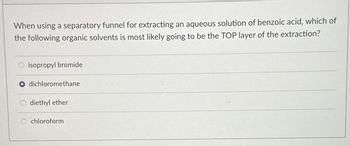
Chemistry
10th Edition
ISBN: 9781305957404
Author: Steven S. Zumdahl, Susan A. Zumdahl, Donald J. DeCoste
Publisher: Cengage Learning
expand_more
expand_more
format_list_bulleted
Concept explainers
Question

Transcribed Image Text:When using a separatory funnel for extracting an aqueous solution of benzoic acid, which of
the following organic solvents is most likely going to be the TOP layer of the extraction?
isopropyl bromide
dichloromethane
diethyl ether
chloroform
Expert Solution
This question has been solved!
Explore an expertly crafted, step-by-step solution for a thorough understanding of key concepts.
Step by stepSolved in 3 steps

Knowledge Booster
Learn more about
Need a deep-dive on the concept behind this application? Look no further. Learn more about this topic, chemistry and related others by exploring similar questions and additional content below.Similar questions
- What is the name of the product formed by the titration of butylamine? Group of answer choices butyl ammonium ion butonium ion butanamide butylamide hydrogen butylamine butane amine ionarrow_forwardcompound given are a common organic solvent. From the pair of compounds, select the solvent with the greater solubility in water.arrow_forwardIn this task you will compare the chemical properties of alcohols and carbonyl compounds. Complete the table below. Aliphatic compound Homologous series Type of reaction(s) addition/substitution/redox Propan-1-ol Propan-2-ol 2-methylpropan-2-ol Ethanal Propanone 2. Describe the similarities and differences in the chemical reactions between alcohols and carbonyl compounds. Include reaction equations.arrow_forward
- Give the systematic (IUPAC) names for these molecules. Boononon cnolonongron. НаСНз CHОССH2СH2СНCHЗ CH3 phenyl propanoate |4-methyl pentane methanoat Incorrect. You mixed up the acyl and alkoxy portions of the molecule. Name the alkoxy part first, followed by the acyl part.arrow_forwardDetermine the structure of the methyl ester and organomagnesium bromide reagents that can be combined to form the following alcohol: Part 1: Draw the bond-line formula for the methyl ester reagent. Disregard stereochemistry. Part 2: Draw the bond-line formula for the organomagnesium bromide reagent. Disregard stereochemistry.arrow_forwardWhich of the following would be most miscible in n-nonane, CH3CH₂CH₂CH₂CH₂CH₂CH₂CH₂CH3? formic acid, COOH ammonia, NH3 n-butane, CH3CH₂CH₂CH3 n-butanol, CH3CH₂CH₂CH₂OHarrow_forward
- Which type of compound typically give 3 peaks ("bands") between approx. 1500-1600 cm in an IR spectrum? Select one: Carbonates Esters Alkaloids Aromatic compoundsarrow_forwardCalculate the percent yield and theoretical yield for the following reaction: reduction of 9-Fluorenone to 9-Fluorenol 0.1063 of 9-Fluorenone 1.75 mL of methanol 0.1432 g of sodium borohydride Final weight of 9-fluorenol = 0.1557 garrow_forwardQuestion 1 You are employed as a co-op student at the Drug and Alcohol Testing Association of Canada (DATAC) developing analytical tests for sports doping agents. You are asked to prepare a procedure for the extraction of methylphenidate, the active compound in Ritalin, from urine samples (consider them as simple aqueous layers, you do not need to consider other components!). The goal of the procedure is to extract the methylphenidate into an organic layer which will then be evaporated and the residue will be tested for the drug. You find that methylphenidate is highly soluble in 2-methyltetrahydrofuran, a bio-renewable solvent. Draw the structure of 2-methyltetrahydrofuran and give two reasons why it is a good solvent choice for liquid-liquid extraction. (Please find the image attached below to help you with this question) Question 2 (cont. from scenario 1). Your colleague is helping you develop the urine test. They suggest that the urine should be adjusted to a pH above 7 before…arrow_forward
- Reaction with which of the following compounds in an acetylide reaction would lengthen the carbon chain by one carbon and add a primary alcohol? ethanal formaldehyde epoxide acetone carbonic acidarrow_forwardGive detailed Solution with explanation needed..don't give Handwritten answerarrow_forwardhow do you separate three organic substances by means of extraction. If the three substances, one is 4-methoxyphenol, one acid, the other substance, 1-phenylethylamine, is a base and the third substance, 1,4-dimethoxybenzene, lacks acid-base properties. The three substances are dissolved in diethyl ether, which is a relatively non-polar organic solventarrow_forward
arrow_back_ios
SEE MORE QUESTIONS
arrow_forward_ios
Recommended textbooks for you
 ChemistryChemistryISBN:9781305957404Author:Steven S. Zumdahl, Susan A. Zumdahl, Donald J. DeCostePublisher:Cengage Learning
ChemistryChemistryISBN:9781305957404Author:Steven S. Zumdahl, Susan A. Zumdahl, Donald J. DeCostePublisher:Cengage Learning ChemistryChemistryISBN:9781259911156Author:Raymond Chang Dr., Jason Overby ProfessorPublisher:McGraw-Hill Education
ChemistryChemistryISBN:9781259911156Author:Raymond Chang Dr., Jason Overby ProfessorPublisher:McGraw-Hill Education Principles of Instrumental AnalysisChemistryISBN:9781305577213Author:Douglas A. Skoog, F. James Holler, Stanley R. CrouchPublisher:Cengage Learning
Principles of Instrumental AnalysisChemistryISBN:9781305577213Author:Douglas A. Skoog, F. James Holler, Stanley R. CrouchPublisher:Cengage Learning Organic ChemistryChemistryISBN:9780078021558Author:Janice Gorzynski Smith Dr.Publisher:McGraw-Hill Education
Organic ChemistryChemistryISBN:9780078021558Author:Janice Gorzynski Smith Dr.Publisher:McGraw-Hill Education Chemistry: Principles and ReactionsChemistryISBN:9781305079373Author:William L. Masterton, Cecile N. HurleyPublisher:Cengage Learning
Chemistry: Principles and ReactionsChemistryISBN:9781305079373Author:William L. Masterton, Cecile N. HurleyPublisher:Cengage Learning Elementary Principles of Chemical Processes, Bind...ChemistryISBN:9781118431221Author:Richard M. Felder, Ronald W. Rousseau, Lisa G. BullardPublisher:WILEY
Elementary Principles of Chemical Processes, Bind...ChemistryISBN:9781118431221Author:Richard M. Felder, Ronald W. Rousseau, Lisa G. BullardPublisher:WILEY

Chemistry
Chemistry
ISBN:9781305957404
Author:Steven S. Zumdahl, Susan A. Zumdahl, Donald J. DeCoste
Publisher:Cengage Learning

Chemistry
Chemistry
ISBN:9781259911156
Author:Raymond Chang Dr., Jason Overby Professor
Publisher:McGraw-Hill Education

Principles of Instrumental Analysis
Chemistry
ISBN:9781305577213
Author:Douglas A. Skoog, F. James Holler, Stanley R. Crouch
Publisher:Cengage Learning

Organic Chemistry
Chemistry
ISBN:9780078021558
Author:Janice Gorzynski Smith Dr.
Publisher:McGraw-Hill Education

Chemistry: Principles and Reactions
Chemistry
ISBN:9781305079373
Author:William L. Masterton, Cecile N. Hurley
Publisher:Cengage Learning

Elementary Principles of Chemical Processes, Bind...
Chemistry
ISBN:9781118431221
Author:Richard M. Felder, Ronald W. Rousseau, Lisa G. Bullard
Publisher:WILEY